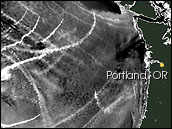For many of us,
cloud formation was one of the first scientific phenomena we
understood. We were taught the sun heats up the water on the Earth's surface
until the water evaporates, gently ascends into the sky, and comes together to
create clouds. It was a simple concept involving just water, the sun, and the
sky. As we grew, we accepted this idea as a basic, easily understood truth.
We’d no sooner doubt it than doubt whether the Earth goes around the sun or
whether static electricity allows a balloon to stick to a wall.
But as it turns out, we've all been misled. Scientists have known for years
that cloud formation is an extremely dirty business that depends on microscopic
particles (aerosols) from the surface of the Earth. These particles allow water
vapor to condense, and without them cloud droplets, mist, or fog could not form
at all.
The presence of the aerosols makes matters much more
complicated in that many researchers do not know exactly where all these
particles come from. While the consensus is that cloud-forming aerosols mostly originate from
natural sources, an increasing number of scientists believe that humans may
produce a large quantity through the burning of fossil fuels. By doing so, we are
making the clouds above us brighter, altering their lifetime and possibly
creating huge changes in our environment.
|
|
 Although clouds appear pristine, aerosols—airborne
grime— are required for water droplets to form. Most aerosols are generated by natural
sources, but human activities are increasing their concentration in the atmosphere. As a result,
the properties of clouds may be changing around the globe. (Photograph by Robert Simmon,
NASA Earth Observatory) |
Testing theories of man-made cloud formation has been a difficult task. In
most urban areas, scientists are unable to discern exactly how pollutants
contribute to forming clouds because the atmosphere over the land is too
tumultuous. As an alternative, researchers from NASA’s Goddard Space Flight
Center and a number of universities around the country have turned to studying
"ship tracks" — clouds formed from the aerosols coming from large
ships. Not significant sources of pollution themselves, ships release their
exhaust into the relatively clean and still marine air, where the scientists
have an easier time of measuring the effects of fossil fuel emissions on cloud
formation.
What they have found is that the sulfur dioxide released from ships’
smokestacks could be forming sulfate aerosol particles in the atmosphere, which
cause the clouds to be more reflective, carry more water and possibly stop
precipitating. This is proof that humans have been creating and modifying clouds
for generations through the burning of fossil fuels. The study may go a long
way towards explaining some of the climactic mysteries in the world, such as why
global warming is affecting the Southern Hemisphere much more quickly than the
Northern Hemisphere (King et al. 1993).
 At the Core of Cloud Formation
At the Core of Cloud Formation
|
 The bright cloud arcs in this image are "ship tracks."
They are often seen in near infrared satellite imagery of the Eastern Pacific, like this
scene from a NOAA weather satellite. (Image courtesy Dr. Michael King, NASA GSFC) |

